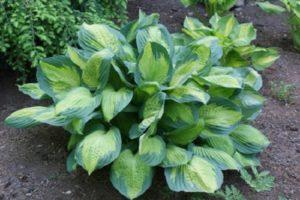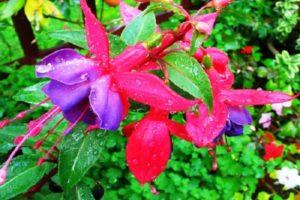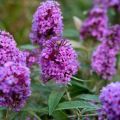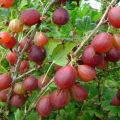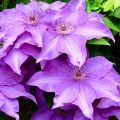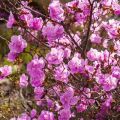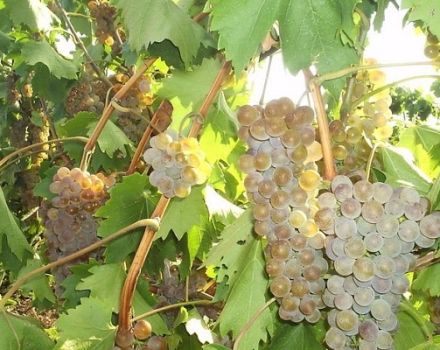Planting, growing and caring for a weigela in the open field
Considering plants for decorating a private plot, it is recommended to pay attention to weigela, since even novice gardeners can handle planting and care in the open ground. The culture is distinguished by long and abundant flowering. There are 10 varieties of weigela suitable for growing in private plots. And each plant species can grow in different climates.
Content
- 1 Description and characteristics
- 2 Types and varieties
- 2.1 Blooming
- 2.2 Variegata, or Nana Variegata
- 2.3 Hybrid
- 2.4 Bristol Ruby
- 2.5 Alexandra
- 2.6 Nana purpurea
- 2.7 Variegated
- 2.8 Middendorf
- 2.9 Early
- 2.10 Sadovaya
- 2.11 Korean
- 2.12 Red prince
- 2.13 Coins
- 2.14 Minor Black
- 2.15 Magic Rainbow
- 2.16 Eva Rathke
- 2.17 Victoria
- 2.18 Carnival
- 2.19 Rosea
- 2.20 Brighella
- 2.21 Candida
- 2.22 Naomi Campbell
- 2.23 Lucifer
- 2.24 Sunny princesses
- 2.25 All summe ed
- 2.26 Red-leaved
- 3 Landing
- 4 Reproduction
- 5 Care rules
- 6 Diseases and pests
- 7 Common mistakes
- 8 Use in landscape design
- 9 Reviews
Description and characteristics
This ornamental shrub from the Honeysuckle family, with white, red, pink and other flowers, was originally cultivated for cultivation in the Far East. But at the same time, it is able to grow in regions with different climatic conditions.
The culture has the following characteristics:
- maximum height - up to 4 meters;
- flower size - up to 5 centimeters;
- flower shape - funnels, bell;
- good frost resistance (depending on the variety).
Weigela does not tolerate dry periods and strong winds. Therefore, the plant is planted in areas protected from drafts and watered abundantly.
Subject to the rules of care, the shrub blooms twice a season. Moreover, the buds, as they open, gradually change color.
Types and varieties
The breeders managed to breed quite a lot of weigela species, each of which has its own characteristics.
Blooming
The shrub reaches a height of three meters. The first flowers with a deep pink tint appear in early June and subside before July. Weigela Blossoming does not tolerate frost, therefore, the plant must be closed for the winter.
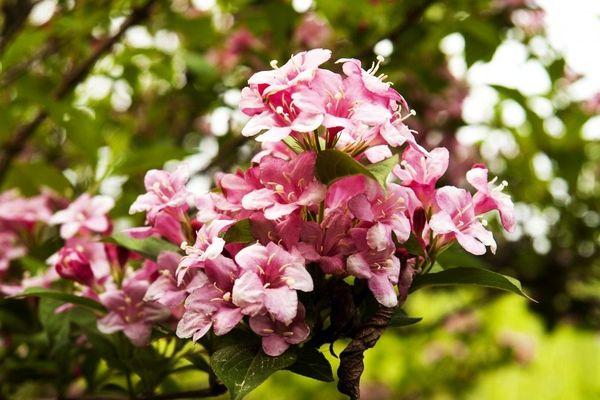
Variegata, or Nana Variegata
A dwarf variety of weigela, characterized by the slow development of shoots and flowers, which are 3-4 pieces collected in inflorescences, with pale pink or crimson petals. Variegata requires landing on the sunny side.
Hybrid
1.5-meter bush with a spreading crown. The color of the funnel-shaped flowers varies depending on the variety of the hybrid weigela.
Bristol Ruby
A shrub with a spreading crown, grows up to four meters in height. Because of this feature, as well as the long flowering period from June to July, the Bristol Ruby variety attracts the attention of gardeners.
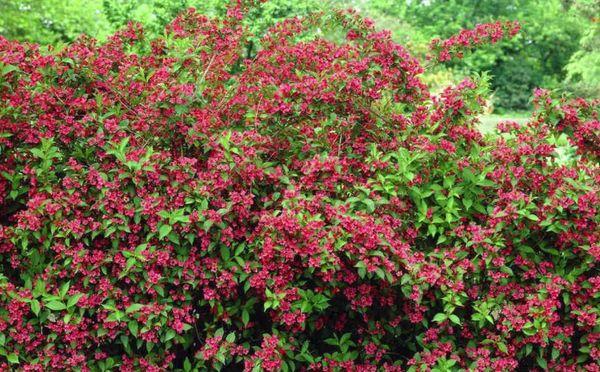
Alexandra
Differs in slow growth (up to 10 centimeters per year). Alexandra's leaves are dark green or almost black, and the flowers are deep pink. Despite its frost resistance, this variety requires shelter for the winter.
Nana purpurea
A purple variety of weigela, reaching a height of one meter. The culture blooms profusely from May to June. The leaves of Nana Purpurea are dark green in color.
Variegated
This variety of weigela stands out due to its variegated leaves. In early summer, tubular flowers form on the shrub, the color of which varies from pale pink to dark.
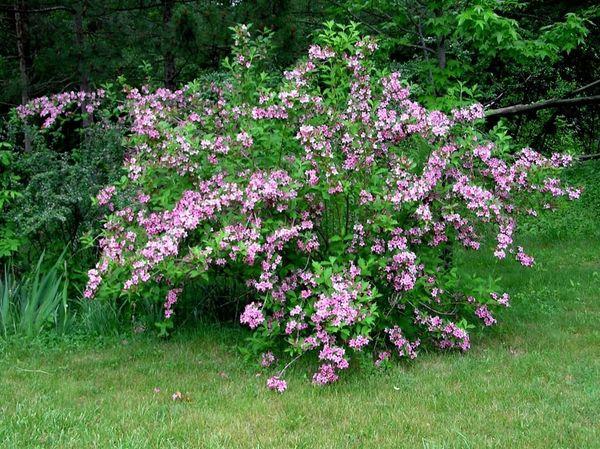
Middendorf
The 1.5-meter shrub gives large (up to 5 centimeters) yellow flowers with bright orange spots. The rich green leaves are oval and fall off after the growing season.
Early
Variety Early grows up to two meters and has a spreading crown with pink inflorescences that fall down stamens. This feature is natural for weigela. The first flowers appear in May.
Sadovaya
The Garden variety reaches no more than a meter in height. On the bush, pink-carmine inflorescences are formed, which take the shape of a bell. The first flowers appear in mid-May and fall off with the onset of summer.
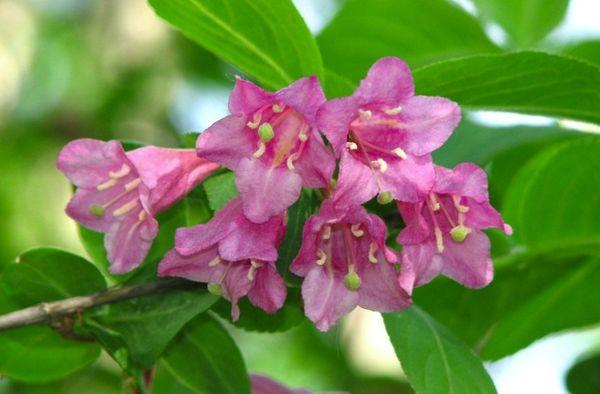
Korean
On the 1.5-meter shrub, large leaves and pale pink inflorescences are formed, the diameter of which reaches 3.5 centimeters. The plant requires shelter for the winter. If this is not done, flowering will begin closer to autumn.
Red prince
A dwarf variety of culture, reaching 50 centimeters in height. The crown of the Red Prince is spreading, with bright red inflorescences.
Coins
Another dwarf variety of weigela, with pink bell flowers and foliage with a pale border, which takes on a burgundy hue closer to spring. The shrub blooms from June to July.
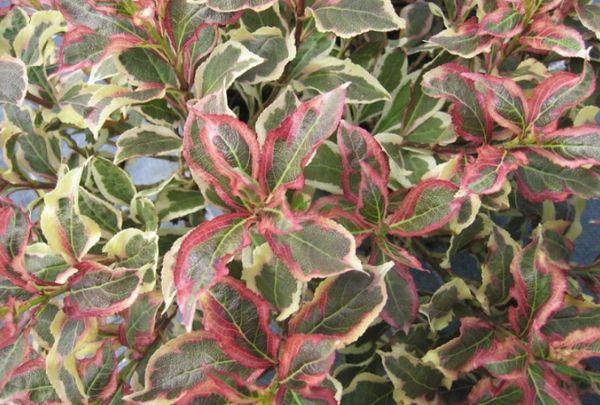
Minor Black
Minor Black has a compact, but dense and lush crown. The shrub height does not exceed one meter. The main feature of this variety is the pointed leaves, the color of which varies from red to dark purple. Minor Black blooms twice a season, forming compact bell flowers of a bright pink hue.
Magic Rainbow
Magic Rainbow is distinguished by pointed leaves, the border of which changes color during the season - from yellow-green to red. Flowering begins in June, provided it grows on the sunny side.
Eva Rathke
Eva Rathke is a Polish weigela variety that grows up to three meters in height. The culture has a compact crown and tubular, red-pink buds. Flowering begins in June and ends with the onset of August.
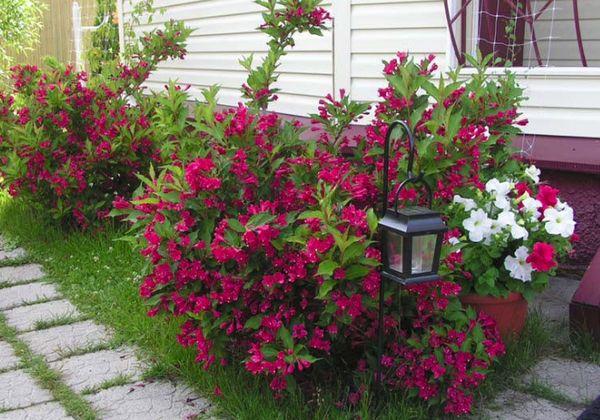
Victoria
On the bushes of Victoria, the height of which reaches one meter, crimson-red buds and green leaves with a brown tint are formed.
Carnival
The shrub of the Carnival variety reaches a height of three meters, and the crown grows 3.5 meters. The buds are distinguished by a variety of colors: both red and pink appear on the same plant. The culture blooms twice a season.
Rosea
Rosea is a hybrid cultivar with lilac-pink flowers and gently curving branches. The maximum height of the shrub does not exceed 1.5 meters. For the period of cold weather, it is recommended to cover the plant, although Rosea tolerates sub-zero temperatures well.
Brighella
Brighella is a medium-sized variety of weigela with ruby bell flowers. The maximum height of the shrub does not exceed 2.5 meters, and the crown width is 2 meters. The leaves are distinguished by the presence of a yellow border around the edges.
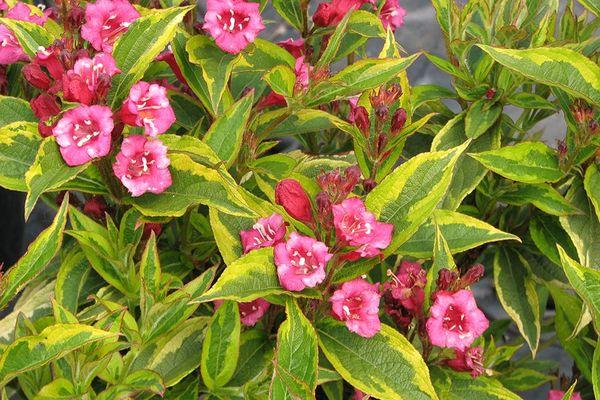
Candida
A hybrid variety of weigela, characterized by 2.5-meter bushes and a 3-meter crown. Candida's flowers are white, bell-shaped, up to four centimeters in size.
Naomi Campbell
The Naomi Campbell variety is distinguished by the slow development of a shrub, whose height reaches 80 centimeters, the crown is 1.2 meters. Castings in this variety are the darkest among all weigels. Naomi Campbell's flowers are purple-red.
Lucifer
This 1.5-meter shrub blooms in early June with large bright red bells. The buds bloom again with the onset of autumn.
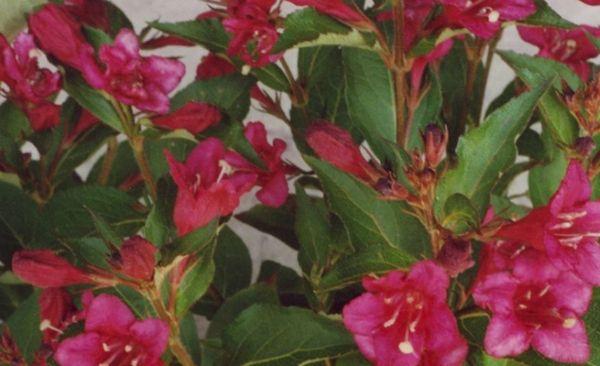
Sunny princesses
The 1.5-meter variety of weigela blooms twice - in late spring and summer. Large pale pink buds appear on the branches of the plant.
All summe ed
A compact variety of culture with a bush, the height of which does not exceed 1.5 meters, crown - 1.8 meters. The main feature of All Summe Red is continuous flowering from May to September.
Red-leaved
Red-leaved stands out due to the original color of the leaves. The height of the shrub does not exceed 1.5 meters.
Landing
Despite the unpretentiousness of the plant, when planting weigela, it is necessary to follow a number of rules that will ensure the annual flowering of the shrub.
Seat selection
For planting, weigels recommend choosing well-lit areas that are protected from strong winds. Gardeners do not recommend growing the plant on the north side. In this case, the flowers will fall early.
How to prepare the soil?
It is recommended to plant bushes in neutral or slightly alkaline soil rich in humus. If the soil does not meet the specified condition, then it is recommended to fertilize the soil:
- peat and sand (for clay soil);
- clay and sand (for peat);
- peat and clay (for sandy loam);
- lime (for soil with high acidity).
The prepared components must be scattered over the site, and then dug up the ground.
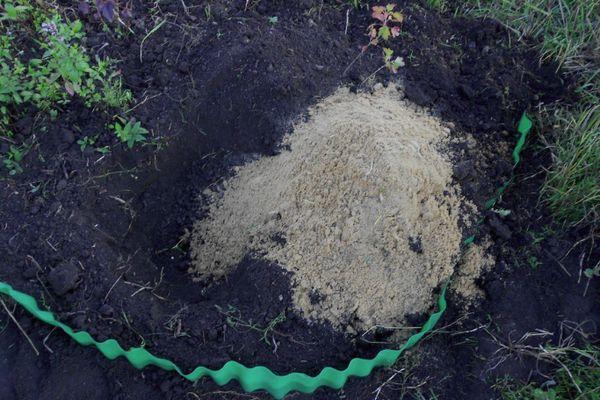
How to plant?
Weigela is planted according to the following algorithm:
- A hole 40 centimeters deep is dug in the prepared area.
- A 15-centimeter drainage layer is laid at the bottom of the pit, consisting of sand or fragments of brick (gravel).
- Together with the drainage, a mixture of 100 grams of nitrophoska and 1.5 buckets of compost is placed on the bottom.
- The seedling is covered with soil, the place is rammed and watered. The root collar is allowed to be buried by 20 millimeters.
It is recommended to treat the root system with a growth stimulator before planting. The minimum distance between holes is determined depending on the selected variety. It is recommended to plant dwarf shrubs at a distance of 0.8 meters, crops with a large crown - 2 meters.
Timing
Weigela is recommended to be planted in the spring, in warm soil, but before the buds swell. During the summer period, the plant manages to take root enough and gain the nutrients necessary for wintering. When planted in autumn, the plant dies after the onset of cold weather.
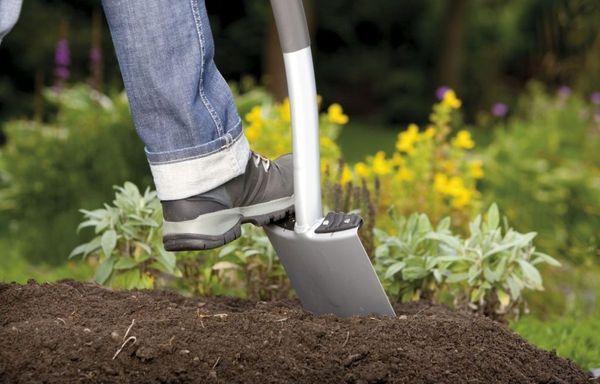
Reproduction
Weigela can be propagated in three ways: by seeds, cuttings and layering. The first option is the most laborious and is not suitable for all varieties of shrubs. Regardless of the selected breeding option, the material must be transplanted into open ground after the onset of spring.
Cuttings
Propagation by cuttings is the best way to breed a crop. To get a new shrub, you need to follow these steps:
- In May, cut off last year's 10-15 centimeters long branch and remove the lower leaves.
- Soak the cutting for 5 minutes in Kornevin's solution, and then plant it in a container with a mixture of sand and peat, deepening it by 2 centimeters.
- Cover the stalk with a jar or bottle.
After the plant grows roots, the weigela needs to be transplanted to a permanent place.
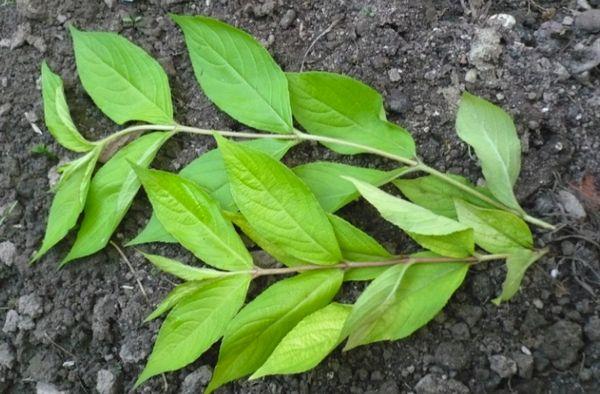
Seeds
Seeds must be harvested with the onset of October-November, when the walls begin to crack. Then the planting material is placed in a dark room until spring.You need to plant seeds after warming up the soil.
This propagation method has two important disadvantages: the planting material rarely sprouts, and the future shrub does not always inherit the properties of the "parent".
Layers
To propagate by layering, it is enough to press the lower shoot to the ground, slightly cutting the bark, and wait until the branch takes root. After that, the plant can be cut off from the parent bush and transplanted to a new location.
Care rules
It is necessary to care for the weigela during the growing season, paying special attention to the shrub in the first year after planting.
Watering
The frequency and amount of watering depends on the weather. During dry periods, it is recommended to pour up to 10-15 liters of water under the plant. After the procedure, it is necessary to loosen the soil in order to exclude the formation of large lumps of soil that interfere with the flow of oxygen to the root system. You should also spray the leaves periodically to remove dust and other traces of dirt.
Top dressing
In the first two years after planting, the weigela is not fertilized. In subsequent seasons, it is recommended to make:
- potash, phosphorus and nitrogen fertilizers (in spring);
- phosphorus-potassium fertilizers (during the period of bud formation);
- wood ash, Fertik or Kemir (in early autumn).
In addition to regularly applying top dressing, it is necessary to remove small weeds around the shrub.
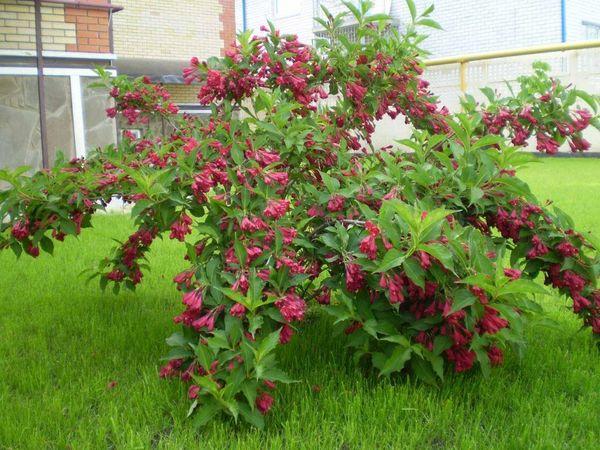
Preparing for winter
Weigela tolerates cold well. If the shrub is planted in the southern regions of Russia, then before the beginning of winter, it is enough to mulch the soil around the plant. When grown in northern latitudes, the lower branches must be bent to the ground. If little snow falls in winter, then the culture needs to provide additional shelter.
Pruning
Weigels are pruned at different times. For the prevention of diseases, it is necessary at the beginning of the period of bud swelling and a month before the onset of cold weather to remove damaged branches, as well as shoots that bend to the ground or grow inside the bush.
Crown formation should be started in the second or third year after planting. In this case, you can cut off any parts of the plant, depending on what kind of shrub the gardener intends to give. To rejuvenate weigela, you need to remove branches older than three years.
Mulching
Mulching is carried out twice in the fall and spring and once in the summer. For this, peat or sawdust is used. With sufficient mulch application, there is no need for weeding and preparation for winter.
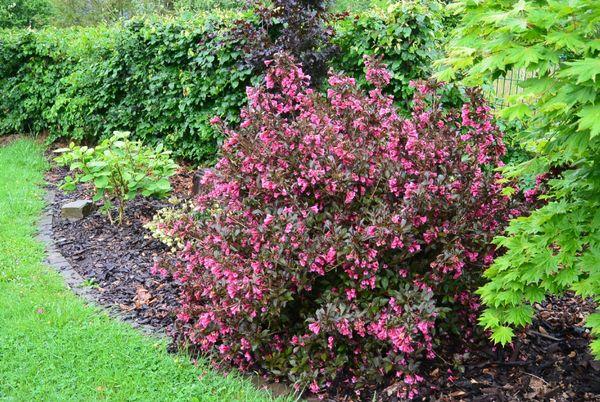
Transfer to another location
Transplanting the plant to a new location is not recommended. But if this cannot be avoided, then the procedure should be carried out in the spring, before the beginning of the growing season. To transplant a bush, it is necessary to dig in the plant, focusing on the length of the crown, and, together with the ground, transfer it to a new place. Then you need to add 30 grams of complex fertilizer to the prepared hole and deepen the bush. At the end of the procedure, the root system must be sprinkled with soil, watered and mulched.
Diseases and pests
On weigel, the following are more common:
- caterpillars;
- aphid;
- thrips;
- spider mites.
The last two types of insects settle on the bushes after the onset of summer. To destroy pests, gardeners use pesticides or insecticidal solutions obtained by infusing garlic, wormwood or hot pepper in water. If the leaves turn yellow prematurely, this indicates the defeat of the root system by a bear or May beetle. Solutions of Karbofos or Aktara, which must be applied at the root, help to destroy pests.
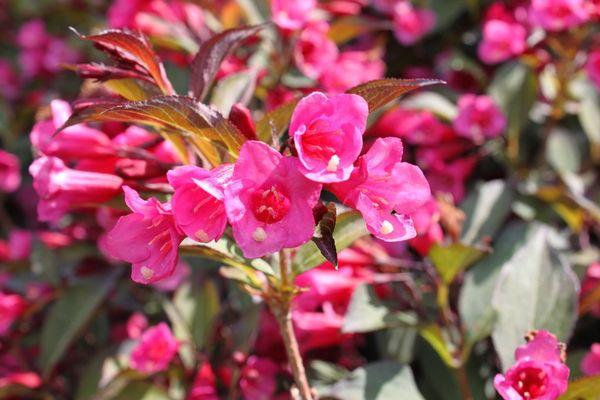
Of the diseases, weigela is more often affected by spotting, rust and gray rot. Bordeaux liquid helps to restore the plant, with which it is necessary to process the bush until the signs of infection completely disappear.
Common mistakes
More often, gardeners, when growing an ornamental shrub, make the following mistakes:
- Planted in shaded areas. Due to the lack of sunlight, the flowers fall early.
- Planted in waterlogged soils. The abundance of moisture contributes to root rot.
- Refuse mulching. Without this procedure, moisture evaporates faster, and the plant dies after the onset of cold weather.
- Refuse preventive treatment for pests. Insects can destroy the culture, so it is recommended to regularly spray the shrub with insecticides.
It is necessary to cover shrubs for the winter, provided that there is not enough snow during the cold season. When planting seedlings in containers, it is recommended to choose deep containers, since some varieties of weigela are distinguished by active development. You also need to correctly and in a timely manner apply fertilizing and cut the bush.
Use in landscape design
Due to its large size and bright, saturated flowers that shower branches, weigela can become a central shrub or divide the garden area into several zones. This culture is often used for communication between tall and low-growing plants. Weigela can be grown as a separate element of landscape design, and as a background frame for other plantings.
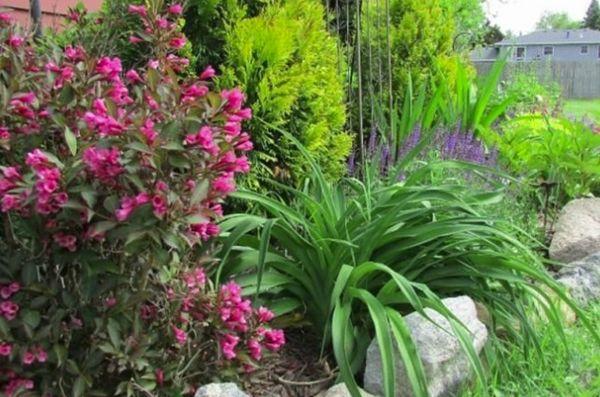
Hedges
This option for planting a bush is considered the most popular. Weigela protects neighboring crops from strong winds, and thanks to its dense crown, it prevents dogs, cats and other animals from entering the area. Tall shrubs can be cut, thereby forming original shapes or a curb that can replace a full-fledged fence. Using a hedge, gardeners zone the site or arrange the entrance to the house.
Tapeworm
The plant is unpretentious. Therefore, weigela is often grown separately from other plantings, against the backdrop of a green lawn. The shrub lends itself to modeling, due to which you can give the culture an original shape and focus on a specific area of the local area. The bush looks especially bright during the flowering period. Because of this, gardeners often plant weigela alleys.
Alpine slides
For the formation of an alpine crust, it is recommended to plant low-growing varieties (up to one meter in height). Such bushes fit well into the created ensemble of garden plantings. Usually dwarf shrubs are grown at the foot of an alpine hill. The bright flowers that characterize this culture go well with large gray stones.
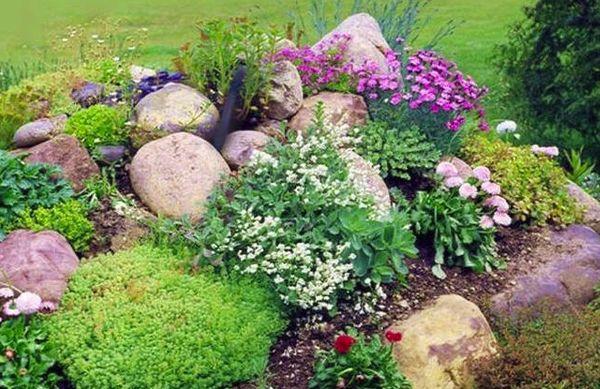
Against the background of coniferous trees
Weigela, planted against the background of conifers, will blend in with perennial plants. This shrub will act as a kind of bright touch that will fill the voids created by monotonous green spaces.
Mixborders
A mixborder is a kind of border (or line) that is formed from green spaces. Through such planting, you can divide the site into several zones, isolate individual plants or alleys from certain crops. And this role can be played by the long-term weigela, which will harmoniously decorate the landscape design, giving a touch of solemnity.
Reviews
Anatoly, Moscow region
“The shrub has been growing at a dacha in the Moscow region for over 10 years. In the early years, flowers rarely appeared on the branches, and quickly fell off, which is why the plant had to be transplanted several times until the optimal place was found. Weigela is a demanding culture for the place of growth. The shrub grown in Central Russia must be constantly fed, watered and mulched. Without these procedures, in the spring, the branches bend down, and spots appear on the leaves. Moreover, after warming up the soil, it is necessary to remove damaged shoots and apply organic fertilizers. "
Elena, Tula
“Weigela was planted in the spring. Already in the summer it became noticeable that the cutting took root well in a new place. The next year, the shrub did not bloom, but at the same time formed a lush and green crown.After consulting in the store where the seedling was purchased, it became clear that without fertilizers, the plant spends all its strength on the formation of leaves. And now the shrub blooms every year. "
